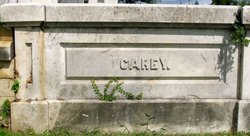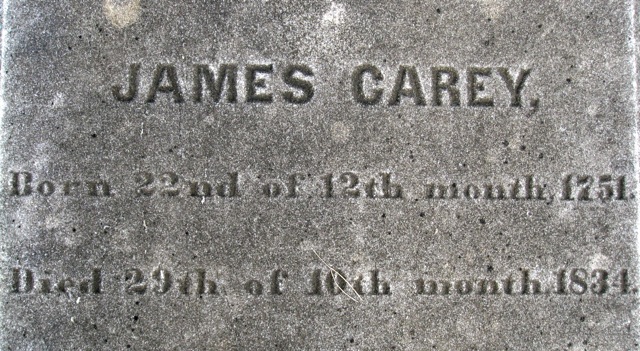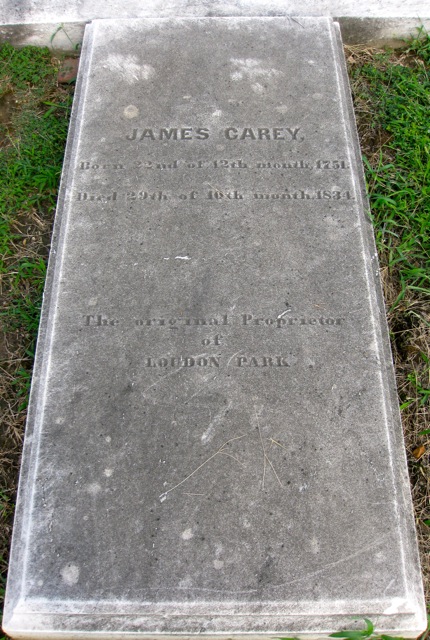Baltimore Gazette and Daily Advertiser. 30 October 1834
"The first of the Carey family to live where Baltimore City now is was John Carey, whose home was on Gwynn's Falls below the Frederick road. He was interested in the mining of iron ore and owned plantations in other counties; was a vestryman in St. Paul's Church, and when he died was buried in Old St. Paul's Cemetery, which was then near the present St. Paul's Church. His daughter married Colonel Christopher Randall, from whom was descended the late James R. Randall, author of "Maryland, My Maryland". George T.M. Gibson of Baltimore is also descended from this marriage.
John Carey's son John died unmarried. His other son James, who was born in Baltimore county in 1752, became one of the principal financiers of old Baltimore and did a good deal toward promoting the prosperity of the city.When the Revolutionary War began Mr. Carey was in England and was detained there on parole until the end of the war. On his return to Maryland he went into the shipping business in Baltimore, exporting tobacco, grain and flour and importing necessities of all kinds. He was the owner of flour mills at Calverton, and with James Cheston and others built the old mill race now part of the city park system. Baltimore became a city in 1796 and James Carey was elected a member of the first city council. In 1790 James Carey, William Patterson, Robert Gilmor, Thomas Hollingsworth, James Edwards and Otho H. Williams organized the Bank of Maryland, of which Mr. Carey was later made president. While under his care the bank was very successful. In the latter part of his life he was much interested in the welfare of the colored people. He died in 1834.
Mr. Carey married in 1785, Martha, daughter of John Ellicott. His country home was "Loudon Park", where he and his wife are now buried, and his town house was at the southeast corner of Sharpe and Lombard streets.........."
From: "Baltimore:Biography" Lewis Historical Publishing Co. pg. 632
Baltimore Gazette and Daily Advertiser. 30 October 1834
"The first of the Carey family to live where Baltimore City now is was John Carey, whose home was on Gwynn's Falls below the Frederick road. He was interested in the mining of iron ore and owned plantations in other counties; was a vestryman in St. Paul's Church, and when he died was buried in Old St. Paul's Cemetery, which was then near the present St. Paul's Church. His daughter married Colonel Christopher Randall, from whom was descended the late James R. Randall, author of "Maryland, My Maryland". George T.M. Gibson of Baltimore is also descended from this marriage.
John Carey's son John died unmarried. His other son James, who was born in Baltimore county in 1752, became one of the principal financiers of old Baltimore and did a good deal toward promoting the prosperity of the city.When the Revolutionary War began Mr. Carey was in England and was detained there on parole until the end of the war. On his return to Maryland he went into the shipping business in Baltimore, exporting tobacco, grain and flour and importing necessities of all kinds. He was the owner of flour mills at Calverton, and with James Cheston and others built the old mill race now part of the city park system. Baltimore became a city in 1796 and James Carey was elected a member of the first city council. In 1790 James Carey, William Patterson, Robert Gilmor, Thomas Hollingsworth, James Edwards and Otho H. Williams organized the Bank of Maryland, of which Mr. Carey was later made president. While under his care the bank was very successful. In the latter part of his life he was much interested in the welfare of the colored people. He died in 1834.
Mr. Carey married in 1785, Martha, daughter of John Ellicott. His country home was "Loudon Park", where he and his wife are now buried, and his town house was at the southeast corner of Sharpe and Lombard streets.........."
From: "Baltimore:Biography" Lewis Historical Publishing Co. pg. 632
Family Members
Advertisement
Records on Ancestry
Sponsored by Ancestry
Advertisement










